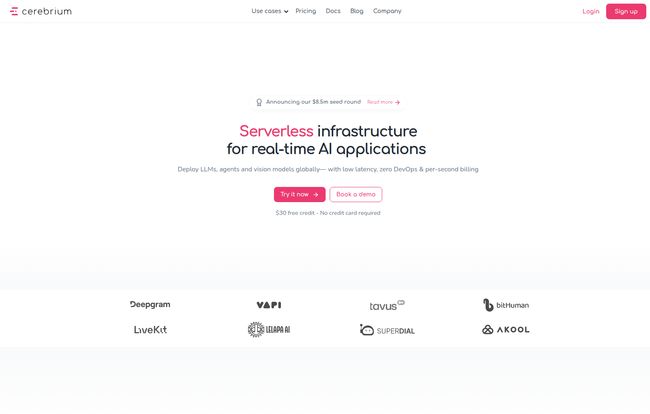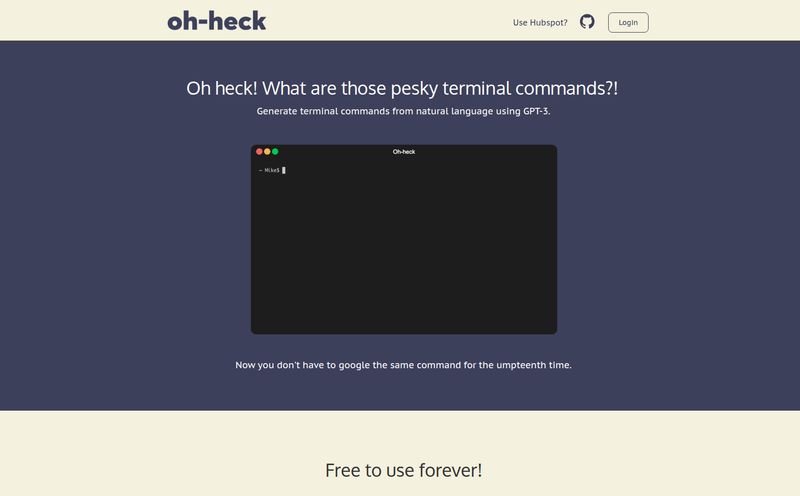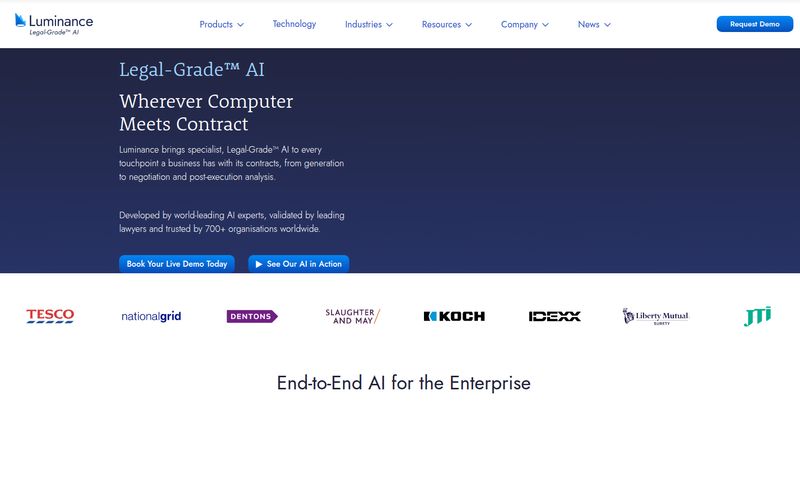If you've ever tried to deploy a machine learning model into the wild, you know the pain. It starts with excitement—you've built this brilliant piece of AI! Then reality hits. You’re wrestling with Docker containers, trying to decipher cryptic AWS billing statements, and praying your Kubernetes cluster doesn’t decide to spontaneously combust at 3 AM. It’s a soul-crushing, budget-devouring monster. I’ve been there, and believe me, it's not the glamorous side of tech.
For years, we've just accepted this as the cost of doing business. You want powerful GPUs? You deal with the maddening complexity of the big cloud providers. But what if there was another way? A platform that promised to handle all that messy infrastructure stuff, letting you focus on, you know, the actual AI. That’s the promise of Cerebrium. And as someone who's seen a lot of 'AWS-killer' platforms come and go, I was skeptical. But after digging in, I think this one... this one might actually have legs.
So, What on Earth is Cerebrium?
Strip away the marketing buzzwords, and Cerebrium is a serverless platform designed specifically for AI. Think of it like this: you have a trained ML model, and you need to get it online so people can actually use it. Instead of renting a server, configuring it, setting up scaling rules, and pulling your hair out, you just hand your code to Cerebrium. They handle the rest.
It’s built on the idea that developers shouldn't have to be expert DevOps engineers just to launch an application. They’re aiming to abstract away the most painful parts of ML deployment—the provisioning, the scaling, the cold starts—and package it into a simple, slick service. You can see from their homepage that companies like Tavus and Sharpr are already on board, which is always a good sign. It's not just some theoretical project; it's being used in production.

Visit Cerebrium
The Features That Actually Matter
Any platform can throw a long list of features on a landing page. But which ones actually make a difference in your day-to-day life? After looking through Cerebrium's offerings, a few things really stood out to me as genuine problem-solvers.
Blazing Fast Cold Starts (No, Seriously)
If you've used serverless functions before, you know the dreaded “cold start.” It’s that initial delay when a function that hasn't been used in a while spins up. For a simple web request, it's annoying. For a massive AI model that needs to load onto a GPU, it can be an eternity. We’re talking seconds, even tens of seconds, which is a lifetime for a user waiting for a response.
Cerebrium claims to have optimized their whole pipeline to make cold starts insanely fast, even for GPU-based models. This is huge. It’s the difference between a real-time AI application that feels snappy and one that feels broken. They seem to have built their entire stack around solving this one, specific, and very painful problem. And from what I can gather, they've done a pretty good job.
Autoscaling That Doesn't Require a PhD
Here’s another classic scenario. Your app is running smoothly. Then you get featured on a big blog or a TikTok goes viral. Suddenly, you have 100x the traffic. With traditional infrastructure, your server would melt. You’d be frantically trying to add more capacity while angry user emails flood your inbox.
Cerebrium’s promise is autoscaling that just… works. It automatically scales your resources up to meet demand and, just as importantly, scales them back down when the rush is over so you’re not paying for idle hardware. It’s designed to handle those spiky, unpredictable workloads without you having to lift a finger. That's the real magic of serverless, and it's a core part of their offering.
A GPU Buffet for Every Appetite
Not all AI models are created equal. Some need the raw power of a top-of-the-line NVIDIA A100, while others are perfectly happy on a more modest A10 or T4. One of the frustrations with some platforms is a limited selection of hardware. You're forced to overpay for a GPU you don’t fully need.
Cerebrium offers a whole menu of GPU options, from the beastly H100 down to more cost-effective choices. This flexibility means you can match the hardware to your model’s specific needs, which is critical for managing costs effectively.
Security and Compliance That Won't Keep You Up at Night
This is the boring but absolutely critical part. Cerebrium is SOC 2 & HIPAA compliant. For anyone outside the enterprise or healthcare worlds, that might sound like alphabet soup. But for those who are, it's a massive green flag. It means they've undergone rigorous audits to prove their systems are secure and can handle sensitive data. It’s table stakes for playing in the big leagues, and it’s a relief to see they've done the work.
Let's Talk Money: The Cerebrium Pricing Model
Alright, this is where things get interesting. Cerebrium uses a usage-based pricing model. At first glance, it’s beautiful. You only pay for the compute time you actually use, down to the second. No more paying for a server that’s sitting idle 90% of the time. They even have a generous free Hobby tier to get you started.
Here’s a quick breakdown of their main plans:
| Plan | Monthly Fee | Best For | Key Features |
|---|---|---|---|
| Hobby | $0 + compute | Developers and small projects | 3 user seats, 3 apps, up to 5 concurrent GPUs, 1-day log retention |
| Standard | $100 + compute | Production applications | 10 user seats, 10 apps, up to 30 concurrent GPUs, 30-day log retention |
| Enterprise | Custom | Large-scale teams | Unlimited everything, dedicated support |
The company claims customers see over 40% cost savings compared to AWS or GCP. That’s a bold claim, and for workloads with inconsistent traffic, I can absolutely see it being true. The catch? You have to be comfortable with a variable bill.
The Not-So-Rosy Side: Potential Downsides
No tool is perfect, and it would be dishonest to pretend otherwise. My job is to give you the full picture. While I'm pretty impressed with Cerebrium, there are a couple of things to keep in mind.
First, that usage-based pricing can be a double-edged sword. While it’s great for saving money on idle time, it can lead to unpredictable bills. If your app usage suddenly explodes, so will your invoice. They do provide a cost estimator on their site, which is helpful, but it's still a forecast, not a guarantee. It's a bit of a gamble; you're betting your usage won't spike without a corresponding revenue jump to cover it.
Second, there's the element of platform lock-in. By building on Cerebrium, you’re building on their turf. Their simplified workflow is fantastic for speed, but it also means you're dependent on their specific way of doing things. Migrating a complex application off Cerebrium and onto another cloud provider down the line would likely be a significant project. It's the classic convenience-versus-control tradeoff that you see with so many great platforms.
My Final Verdict: Who is Cerebrium Really For?
So, after all that, what’s the final word? I think Cerebrium is a fantastic tool for a specific type of user.
If you're a startup or a small team trying to get an AI product to market quickly, Cerebrium is a no-brainer. The amount of time and headache you'll save on infrastructure is immense, and that speed can be a huge competitive advantage.
If you're a developer at a larger company tasked with building a new AI feature or prototype, it's also a perfect fit. You can spin up a production-ready service in a fraction of the time it would take to go through internal DevOps processes.
And if your application has that spiky, unpredictable traffic pattern, the serverless model is practically designed for you.
Who is it not for? Maybe a massive corporation with a deeply entrenched, highly optimized infrastructure and a huge team of DevOps engineers who have already squeezed every last drop of performance out of their AWS setup. But even then, the Enterprise plan suggests Cerebrium wants a piece of that pie too. For everyone else, it’s a very, very compelling alternative to the old way of doing things.
The world of ML deployment is shifting. We're moving away from the idea that every developer needs to be a systems administrator. Platforms like Cerebrium are at the forefront of this change, making powerful AI more accessible to everyone. If you’re tired of fighting with infrastructure, I'd say it's absolutly worth giving their free tier a spin.
Frequently Asked Questions about Cerebrium
- What is Cerebrium used for?
- Cerebrium is primarily used for deploying, managing, and scaling machine learning and artificial intelligence models. It's a serverless platform, meaning it handles all the underlying server infrastructure, so developers can focus on their code. It's ideal for real-time applications, batch processing jobs, and AI services that need GPU acceleration.
- How does Cerebrium save money compared to AWS/GCP?
- The main cost saving comes from its serverless, pay-for-what-you-use model. With traditional cloud providers like AWS or GCP, you often pay for reserved instances, which are running (and costing you money) 24/7. With Cerebrium, you only pay for the exact compute time your application uses, down to the second. For applications with variable or intermittent traffic, this can lead to significant savings by eliminating the cost of idle time.
- Is Cerebrium suitable for production applications?
- Yes, absolutely. It's designed for production use, with features like automatic scaling, high uptime (they claim 99.999%), and real-time logging and observability. Furthermore, its SOC 2 and HIPAA compliance make it a secure choice for commercial applications, even those handling sensitive data.
- What kind of support does Cerebrium offer?
- Support varies by plan. The free Hobby plan includes community support via Slack and Intercom. The paid Standard plan offers more dedicated support, while the Enterprise plan comes with a dedicated Slack channel and premium support for mission-critical applications.
- How does the usage-based pricing work?
- You pay a per-second rate for the specific hardware your code runs on (CPU, memory, and any GPU). There is a base monthly fee for the Standard and Enterprise plans, but the bulk of the cost is directly tied to your application's actual resource consumption. When your app is idle and not processing requests, you're not incurring compute costs.



